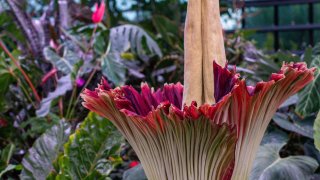
If you haven’t smelled it yet, there’s another corpse flower getting ready to bloom at the San Diego Botanic Garden this week following the appearance of their "sibling" plant a few weeks ago.
"Morticia," the garden's second corpse flower this year, began its bloom on Wednesday, and the garden is extending its hours from July 17 to July 19 to get as many noses in the building as possible.
The flower is most odorous in the evening, so the garden will be extending its hours at the Dickinson Family Education Conservatory at the Garden as follows:
- July 17: Open until midnight
- July 18: 7 a.m. - 10 p.m.
- July 19: 7 a.m. - 8 p.m.
Get top local stories in San Diego delivered to you every morning. Sign up for NBC San Diego's News Headlines newsletter.
The flower first flourished the weekend of June 28, after a long-awaited arrival with only a few hours to witness its powerful smell. The public named this flower Uncle Fester after a naming contest hosted by the conservatory. And now, a second flower makes its surprising debut.
The Amorphophallus titanum, better known as the corpse flower, emits a powerful odor in full bloom for 48 hours and is described as a rotting corpse or carcass. The bloom of a corpse flower is a special and uncommon event since most corpse flowers need seven to ten years to bloom for the first time and only bloom again thereafter every four to five years.
San Diego Garden Botanic Garden encourages people to stay regularly updated via social media to get a chance to see this rare flower.

According to San Diego Botanic Garden (SDBG), these two plants appear to be on the same cycle as both have previously bloomed within 30 days of each other, first in 2018 and a second time, also together, in 2021
“We are extremely fortunate to be presenting our second corpse flower bloom of the year from a plant within our permanent collection,” said SDBG President and CEO, Ari Novy, PhD. “This particular plant is a sibling to the plant that just bloomed here in late June. The response to that recent bloom was incredible, and we cannot wait to share this experience with the community once again. If you didn’t have a chance to come check out the last bloom, this is your opportunity.”
Ways to stay updated and see Corpse Flower this summer
- Instagram: @SanDiegoBotanicGarden
- Facebook: San Diego Botanic Garden
24-hour corpse plant livestream
Things change quickly for a blooming corpse flower, so the garden is recording a 24-hour live stream of the plant available here (dubbed Corpse Cam).
Why does the corpse flower stink?
The corpse flower earned its nickname by imitating the odor of rotten meat in order to attract pollinators like carrion beetles and flies, according to SDBG. In order to increase its chances of pollination, its large spadix (the big yellow stem sticking out of the middle) generates heat, raising its scent high into the trees so it can attract those pollinators from farther away.
Those who've dared to smell it have described it as smelling like cheese, garlic, stinky feet, diapers or rotten fish!
Why is the corpse flower's bloom so rare?
Most of these Sumatran-rainforest-native plants need to age seven to 10 years before blooming for the first time. After that, they bloom only every four or five years afterwards.
After fully blooming, it will emanate its famous stench for only three days before starting to close up and decay slowly over the next few weeks.
Current top stories on NBC 7 San Diego
“The corpse flower is the smelly rock star of the plant world,” said Novy.
“Its putrescence attracts pollinators in its native habitat in Sumatra, Indonesia, while also attracting curious humans from around the world excited to experience this beautiful, stinky, giant inflorescence.”





